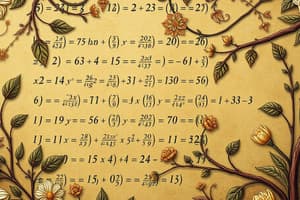Podcast
Questions and Answers
Determine the total number of roots of the polynomial function f(x) = 3x^6 + 2x^5 + x^4 - 2x^3.
Determine the total number of roots of the polynomial function f(x) = 3x^6 + 2x^5 + x^4 - 2x^3.
6
Determine the total number of roots of the polynomial function g(x) = 5x - 12x^2 + 3.
Determine the total number of roots of the polynomial function g(x) = 5x - 12x^2 + 3.
2
Determine the total number of roots of the polynomial function f(x) = (3x^4 + 1)^2.
Determine the total number of roots of the polynomial function f(x) = (3x^4 + 1)^2.
8
Determine the total number of roots of the polynomial function g(x) = (x - 5)^2 + 2x^3.
Determine the total number of roots of the polynomial function g(x) = (x - 5)^2 + 2x^3.
Determine the total number of roots of the polynomial function using the factored form f(x) = (x + 1)(x - 3)(x - 4).
Determine the total number of roots of the polynomial function using the factored form f(x) = (x + 1)(x - 3)(x - 4).
Determine the total number of roots of the polynomial function using the factored form f(x) = (x - 6)^2(x + 2)^2.
Determine the total number of roots of the polynomial function using the factored form f(x) = (x - 6)^2(x + 2)^2.
Determine the total number of roots of the polynomial function using the factored form f(x) = (x + 5)^3(x - 9)(x + 1).
Determine the total number of roots of the polynomial function using the factored form f(x) = (x + 5)^3(x - 9)(x + 1).
Determine the total number of roots of the polynomial function using the factored form f(x) = (x + 2)(x - 1)[x - (4 + 3i)][x - (4 - 3i)].
Determine the total number of roots of the polynomial function using the factored form f(x) = (x + 2)(x - 1)[x - (4 + 3i)][x - (4 - 3i)].
Find the root(s) of f(x) = (x - 6)^2(x + 2)^2.
Find the root(s) of f(x) = (x - 6)^2(x + 2)^2.
Find the root(s) of f(x) = (x + 5)^3(x - 9)^2(x + 1).
Find the root(s) of f(x) = (x + 5)^3(x - 9)^2(x + 1).
Determine the number of x-intercepts that appear on the graph of the function f(x) = (x + 1)(x - 3)(x - 4).
Determine the number of x-intercepts that appear on the graph of the function f(x) = (x + 1)(x - 3)(x - 4).
Determine the number of x-intercepts that appear on the graph of the function f(x) = (x - 6)^2(x + 2)^2.
Determine the number of x-intercepts that appear on the graph of the function f(x) = (x - 6)^2(x + 2)^2.
Determine the number of x-intercepts that appear on the graph of the function f(x) = (x + 5)^3(x - 9)(x + 1).
Determine the number of x-intercepts that appear on the graph of the function f(x) = (x + 5)^3(x - 9)(x + 1).
Determine the number of x-intercepts that appear on the graph of the function f(x) = (x + 2)(x - 1)[x - (4 + 3i)][x - (4 - 3i)].
Determine the number of x-intercepts that appear on the graph of the function f(x) = (x + 2)(x - 1)[x - (4 + 3i)][x - (4 - 3i)].
Describe the graph of the function at its roots f(x) = (x - 2)^3(x + 6)^2(x + 12): At x = 2, the graph _______ the x-axis.
Describe the graph of the function at its roots f(x) = (x - 2)^3(x + 6)^2(x + 12): At x = 2, the graph _______ the x-axis.
Describe the graph of the function at its roots f(x) = (x - 2)^3(x + 6)^2(x + 12): At x = -6, the graph ______ the x-axis.
Describe the graph of the function at its roots f(x) = (x - 2)^3(x + 6)^2(x + 12): At x = -6, the graph ______ the x-axis.
Describe the graph of the function at its roots f(x) = (x - 2)^3(x + 6)^2(x + 12): At x = -12, the graph ______ the x-axis.
Describe the graph of the function at its roots f(x) = (x - 2)^3(x + 6)^2(x + 12): At x = -12, the graph ______ the x-axis.
G(x) = (x + 4)^4(x - 9): At x = -4, the graph ______ the x-axis.
G(x) = (x + 4)^4(x - 9): At x = -4, the graph ______ the x-axis.
G(x) = (x + 4)^4(x - 9): At x = 9, the graph ______ the x-axis.
G(x) = (x + 4)^4(x - 9): At x = 9, the graph ______ the x-axis.
If you know a root of a function is -2 + \sqrt{3}i, then _____.
If you know a root of a function is -2 + \sqrt{3}i, then _____.
Three roots of the polynomial function f(x) = x^5 - 8x^4 + 21x^3 - 12x^2 - 22x + 20 are -1, 1, and 3 + i. Which of the following describes the number and nature of all the roots of this function?
Three roots of the polynomial function f(x) = x^5 - 8x^4 + 21x^3 - 12x^2 - 22x + 20 are -1, 1, and 3 + i. Which of the following describes the number and nature of all the roots of this function?
Identify all of the root(s) of g(x) = (x^2 + 3x - 4)(x^2 - 4x + 29).
Identify all of the root(s) of g(x) = (x^2 + 3x - 4)(x^2 - 4x + 29).
Use the fundamental theorem of algebra and the complex conjugate theorem to determine the number and nature of the remaining root(s) for f(x) = x^3 - 7x - 6, given that two roots are -2 and 3.
Use the fundamental theorem of algebra and the complex conjugate theorem to determine the number and nature of the remaining root(s) for f(x) = x^3 - 7x - 6, given that two roots are -2 and 3.
Flashcards are hidden until you start studying
Study Notes
Fundamental Theorem of Algebra
- The total number of roots of a polynomial function equals its degree.
Polynomial Functions and Their Roots
- For the polynomial function f(x) = 3x^6 + 2x^5 + x^4 - 2x^3, there are 6 roots.
- For g(x) = 5x - 12x^2 + 3, the total number of roots is 2.
- The function f(x) = (3x^4 + 1)^2 has 8 roots.
- For g(x) = (x - 5)^2 + 2x^3, there are a total of 3 roots.
Factored Form and Roots
- The polynomial f(x) = (x + 1)(x - 3)(x - 4) has 3 roots.
- For f(x) = (x - 6)^2(x + 2)^2, the total number of roots is 4.
- The function f(x) = (x + 5)^3(x - 9)(x + 1) has 5 roots.
- For f(x) = (x + 2)(x - 1)[x - (4 + 3i)][x - (4 - 3i)], it contains 4 roots.
Identifying Specific Roots
- The roots of f(x) = (x - 6)^2(x + 2)^2 include 6 (multiplicity 2) and -2 (multiplicity 2).
- For f(x) = (x + 5)^3(x - 9)^2(x + 1), the roots are -5 (multiplicity 3), 9 (multiplicity 2), and -1 (multiplicity 1).
X-intercepts on Graphs
- The function f(x) = (x + 1)(x - 3)(x - 4) has 3 x-intercepts.
- For f(x) = (x - 6)^2(x + 2)^2, there are 2 x-intercepts.
- The function f(x) = (x + 5)^3(x - 9)(x + 1) also has 3 x-intercepts.
- For f(x) = (x + 2)(x - 1)[x - (4 + 3i)][x - (4 - 3i)], there are 2 x-intercepts.
Graph Behavior at Roots
- In f(x) = (x − 2)^3(x + 6)^2(x + 12):
- At x = 2, the graph crosses the x-axis.
- At x = -6, the graph touches the x-axis.
- At x = -12, the graph crosses the x-axis.
- For g(x) = (x + 4)^4(x − 9):
- At x = -4, the graph touches the x-axis.
- At x = 9, the graph crosses the x-axis.
Complex Conjugate Theorem
- If a root of the function is -2 + sqrt(3)i, the corresponding known root is -2 - sqrt(3)i.
Analysis of Roots in a Polynomial
- For f(x) = x^5 - 8x^4 + 21x^3 - 12x^2 - 22x + 20, having roots -1, 1, and 3 + i:
- The function has three real roots and two imaginary roots.
Identifying Roots from a Polynomial
- For g(x) = (x^2 + 3x - 4)(x^2 - 4x + 29), the roots include 1, -4, and two non-real roots: 2 + 5i and 2 - 5i.
Remaining Roots Calculation
- For the polynomial function f(x) = x^3 − 7x − 6, with known roots -2 and 3:
- The degree of the polynomial is 3, indicating 3 roots total.
- Since two roots are given, one additional real root remains, inferred from the complex conjugate theorem which requires any imaginary roots to appear in pairs.
Studying That Suits You
Use AI to generate personalized quizzes and flashcards to suit your learning preferences.




